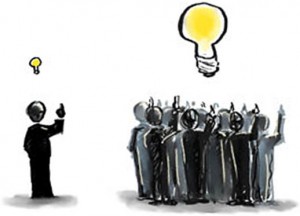
On the surface it’s simple, you make an open-call to the world asking for help to solve a problem. Crowdsourcing enables a myriad of people to engage online and combine efforts towards a central purpose. From Wikipedia to Open-Source Coding, the effects of this wildly effective concept have been proven over the past several years. Now companies are emerging that revolve an entire business model around outsourcing tasks to their networks. The costs are relatively low and the rewards are high. Many are rising up through the ranks, such as the software testing go-to uTest, but many are not… and here’s why.
Before I get into the good stuff though, credit is due where a lot of these ideas came from. I attended a panel at the Microsoft Nerd Center this week where the topic was Crowdsourcing. Though many offered insights and tidbits, the moderator Jeff Howe, also known as the father of Crowdsourcing, was by far the most enlightening. I guess you have to know your stuff to be the guy who literally wrote the book.
First off, you need to set the rules for the crowd. Having a set of standards for what is acceptable through forums and the community makes it clear what those in control will regulate. It’s usually not advised to have an unregulated environment because of spam and malicious invaders, but on the flip side too many constraints and nobody will be able to collaborate. If you’ve ever seen a Wikipedia discussion thread, it’s a perfect example of how much effort goes into even small bits of the projects, and the rules help to organize the flow of the work.
Winners and Losers. There has to be something in it for the crowd. Though some are successful with a purely altruistic model, many companies are out to make money and the people helping you want a slice of the pie. How you divvy up the pie is your call, but rest assured there are many issues with contractors actually being an employee and it’s best to have professional legal advice before embarking and winding up bankrupt from a lawsuit. Having a winner take all method is great to spur competition, but it may sour a lot of the crowd who’s effort and diligence was for nothing.Figure out what works best for you and work with those who are an asset.
Hierarchy is another critical element of crowdsourcing. Many unknowingly believe that crowdsourcing is some idealistic meeting ground where everyone is equal. This is not the case. There is always some structure because controls need to be managed to keep the project moving forward. Whether it’s a top-down or a bottom-up approach, some people have to be steering the ship. Without leadership the project will amount to very little.
Though it’s still relatively new, crowdsourcing is shaking up the way business is being done. From encyclopedia to project management, many new companies are finding that it’s more cost-effective to utilize a crowd, and with the right controls, the results are superb.
